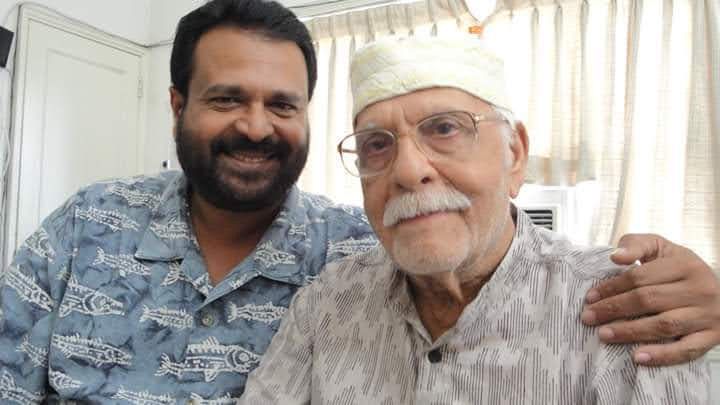
Jayanan Vincent 100:Part 2!
Jan 18 2024
SICA is proud to present glorious visual journey of Ace Cinematographer Jayanan Vincent who has captured 100 films is unique feet at any part of film making world.

Here his journey continues as Part 2 a conversation with SICA.
**Airport as a Canvas:** “Airport” explored a unique setting for a Tamil film. How did you use the visual elements of the airport to tell the story and create a distinct atmosphere?
Another feature to be filmed in the capital, New Delhi was ‘Airport’. It was Joshi’s debut in Tamil. S. N. Swamy, the mastermind behind the investigative thriller CBI series, who made his debut in Tamil with ‘Mounam Samadham’ was roped in as writer for ‘Airport’.
It was not a run of the mill story and a risky project to attempt during those times.

A dashing young producer, G. S. Madhu took over the production from another producer before the launch. He acted as the co-pilot who gets strangled in the men’s room of the terminal building in the opening sequence of the movie.
‘Airport’ was a thriller devoid of the regular songs, lots of action sequences and an emotion packed second half. Most of the airport sequences were filmed in the Indira Gandhi International Airport and Safdarjung Airport. It was decided to capture the grandeur on the tarmac, taxiing airplanes and the beauty of the prime locations in Delhi. Joshi had this penchant for super wide shots and super tight shots.
Sathyaraj was cast as the protagonist. I must say, it’s one among his best performances to date. The ensemble of ‘Airport’ was huge and multi-lingual thereby causing innumerable delays in production.
We used the Cine Jib extensively for the crane and dolly shots for most sequences filmed in New Delhi. The night scenes near India Gate was filmed at the crack of dawn due to the uncontrollable crowds during late evenings. (India Gate is where public hang out like we do in Marina beach.) HMI’s were placed to backlight the tall trees while tungstens lit the talent. Keeping pace with the brightening sky was a challenge and I believe we spent two early mornings to film that sequence of Sathyaraj, Gautami & Charlie at the India Gate.
Our plans for a certain visual underwent a debacle as major scenes were filmed in Chennai and Mysore during summer and no way a match for the smoggy Delhi nights in winter and the soft hazy days. My brother, Ajayan Vincent also helped film a few scenes in Chennai during my absence.
The climax was filmed on the dry river bed in Tala Cauvery. This sequence was filmed with telephoto lenses and electric hot plates to create a mirage effect. Our A cam had an Angenieux 50-500mm zoom lens and the B cam Kowa Anamorphic lenses for hand held shots in the chopper. Follow focus at 200mm or 250mm was critical and the focus pullers did an extraordinary job. Hats off! The movie faired satisfactorily at the box office. Even cinematography wise, I fell short of expectations.
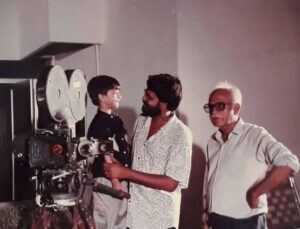
* Adapting to Changing Landscapes: The Indian film industry has undergone significant transformations over the years. How have you adapted your style and approach to stay relevant and successful throughout your career?
An intriguing question… I guess, I’ll have to begin from the grassroots for a better understanding. Firstly, we hail from a family of stills photographers. My grandfather, George Vincent, owned Chitra Studios in Calicut in the early 1930’s and as a young boy, my dad, A. Vincent’s extended playpen was the photo studio. Watching his father at work, my dad learned the rudiments of lighting, photographing and the darkroom techniques of processing and printing.
During my apprenticeship in late 1975 for the Telugu movie, ‘Jyothi’ in Black & White, I was put under the tutelage of stills photographer, Gudiseva Shyamkumar, son of renowned stills photographer, Late Sri. Chittibabu. We worked out of a darkroom set up in a guest house in an idyllic vineyard in Ameerpet, Hyderabad. The magic began to unfold… latent images transformed into visible images on the negative and negative to prints. Long nights, long hours and hard work paid off. I learned the darkroom procedures of prepping developers & fixers, processing negatives and printing. I looked forward to another long night in the warm glow of the darkroom after a hectic day of shoot.
The transition from Black and White to Colour was in quick progression during the late 1975’s. Luckily, I branched off doing independent features in black & white in late 1977 like ‘Mariyamman Thiruvizha’ (Tamil), Aanapachan (Malayalam) and ‘Ente Neelakasam’ (Malayalam) in 1978. And a spate of colour films assisting my father during the downtime of independent features. The on-set experience and the knowledge accumulated paid off handsomely.
I did spend hours at the USIS library in Chennai, browsing books on photography and cinematography and also viewing classic American movies like ‘12 Angry Men’ and many, many others every weekend at the in-house theatre. After every show, I would walk back home pondering over the compositions, lighting and camera moves. These images stayed imprinted in my memory.
I was an avid reader. I leafed through dozens and dozens of American Cinematographer. I also watched innumerable movies in the theatres especially movies done by my favourite Hollywood cinematographers.
I took every opportunity to personally meet and interact with the legendary cinematographers of Tamil, Telugu, Malayalam, Kannada & Hindi movies.
Sri. Maruti Rao, Sri. C. V. Ramakrishnan (Thambu), Sri. Marcus Bartley, Sri. P. L. Rai, Sri. Viswanath Rai, Sri. B. S. Lokanathan, Sri. T. S. Vinayagam, Sri. N. K. Viswanathan, Sri. Babu, Sri. U. Rajagopal, Sri. C. Ramachandra Menon, Sri. D. V. Rajaram, Sri. V. Durga Prasad, Sri. Kaka Thakur & Sri. D. K. Prabhakar are among the greats I met and respected. Most of them gave me the express permission to observe them at work on the sets.
It was a wonderful learning process of discovering different styles and perspectives. I’ve ardently watched most movies of the above mentioned cinematographers and admired their creative approach. I’m so eternally grateful and obliged to the cream of yesteryear cinematographers who’ve inspired me to set higher goals. Every meeting, every advice, every movie went into the folders of my mind’s digital archive. ‘A card up one’s sleeve’ as the saying goes.
Inspired by the images I had seen, I began to incorporate, adapt and experiment it in the movies. Always striving to make a difference in presentation and the array of shots. I loved to film with the Mitchell camera in tandem with an Arriflex. To my surprise, the so called new-wave directors preferred the handy Arriflex to the cumbersome Mitchell. I decided to go with the flow.
I think adaptability is critical in the event of the rapid change in the visual media. In the years to follow, my relentless curiosity gathered more momentum. Unfortunately, the perks of being busy is, one hardly finds time to read or watch movies at a leisurely pace. However, I think the curiosity to learn and experiment has kept me motivated. Visualization can help reinvigorate your motivation creating a sense of excitement and anticipation.
*Legacy of A. Vincent:Your father, A. Vincent, was a pioneer in Indian cinema. How has his influence shaped your own career and artistic vision?
I was lucky to be born with a silver spoon so to say. As a youngster, I’ve had the opportunity to visit his sets and attend previews of most of my father’s movies. He took my brother and I to the recording theatres for the final mix. It was there we had first hand experience creating and synchronizing sound effects. It was fun to go to the edit rooms, too, to collect souvenirs like film clippings and pure white cotton gloves. (Editors wore those white cotton gloves whilst handling negatives) So the exposure and interest in filmmaking began at a very tender age.
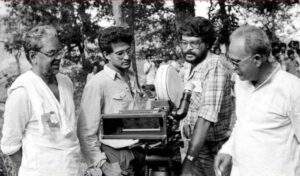
My brother, Ajayan and I had access to a stills camera, an Asahi Pentax SLR with rolls of black & white at our disposal. Photography was an expensive hobby, but my father always had our backs. I mean he bankrolled our processing and printing charges of Bengal Photo Studio in T. Nagar, Madras. He’d review our pictures and make suggestions about compositions, lighting and the quality of the print. For us though, it didn’t make real sense at that time.
In the late 75’s, I began assisting my father. He insisted I do a detailed camera report – scene, shot, NG/OK take numbers, film stocks, lenses, filters, aperture, camera movements and whether it was a mid-shot or long shot or close up. Observe closely and maintain accuracy was his advice.
It was, at that point, I realized the respect and admiration my father had commanded amongst the crew and cast. It was during that shoot my outlook changed, I accepted him as a mentor/guru. Master, as he was rightfully called, became my master as well. I saw him in that light, in my mind’s eye. His long time disciple, K.S. Prakash was his operative cameraman on that project. The movie was ‘Jyothi’ shot in Hyderabad and directed by K. Raghavendra Rao. It was KRR’s second movie.
‘Prema Lekhalu’ was directed by K. Raghavendra Rao for Annapurna Pictures (P) Ltd., in 1976. My father made a surprise decision to shoot the movie on Kodak B&W negative. Kodak (India) was kind enough to import a consignment for the movie. It had an assortment of Plus X, Double-X, Tri-X and 4-X stocks. Remember, it was a period when ORWO was ruling roost in supplying black & white negatives like NP 55 and NP 7. I was super thrilled as I could bag some Kodak roll ends for my film cassettes. The production owned Arriflex II B was the A cam for the project. A Mitchell camera, too, was brought in for some on-camera special effects and dissolve shots for a song. The tonal range was remarkable from the blacks to white, soft and velvety, starkly different from the regular black & white movies we had shot earlier. Unfortunately, never had a chance to work with that stock again. And the cherry on the pudding was that the cinematography of ‘Prema Lekhalu’ was highly appreciated.
Cinematographer V. Jayaram was the first AC/Focus Puller of the Arriflex II B. We struck a friendship which lasted till he passed away. He did some great movies as a cinematographer for director I. V. Sasi
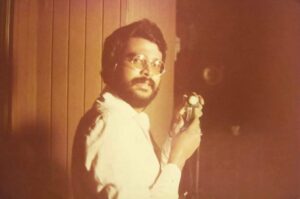
A few days before ‘Prema Lekhalu’ wrapped up, I was given the Sekonic Exposure Meter to come up with key and fill readings in footcandles (fc)for a scene. For Kodak Plus X, 100 ASA 100 foot candles T2.8 was the formula followed and the key at 70 fc and fill at 30 fc for a 3:1 ratio. (Key + Fill : Fill) or (70 + 30 : 30) or (100 : 30). We did a 4:1 ratio for the night effects. This is just a break down of how ratios were calculated during the analog era. I must say I enjoyed the stint doing the foot candle readings. My father, on the other hand, went about the set and read light off his palms. He didn’t need an exposure meter. He would say this key light is 15 foot candles more and he was accurate.
And yeah, having a Sekonic meter in the front pocket of the shirt and the black chord wrapped around the neck was a moment of pride and prestige.
I, too, went through that phase and I know many others are breaking into a smile thinking of that moment.
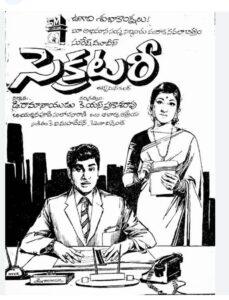
The first ever feature film to be shot at Annapurna Studios, Hyderabad was ‘Secretary’ in 1976. Sri. K. S. Prakash Rao (Sr) was the director. A huge set was erected in floor one. An interior of a mansion. I must say this set was immaculately lit. K. S. Prakash, S. Navakanth, Ravindra Babu and I were part of the camera crew. Lighting for a night effect scene in the master bedroom with massive glass windows was completed. A fairly large balcony with night sky visible through the glass windows. The painted sky was lit with skypans. It had a bluish hue like the late dusk sky. Prakash, jokingly, quipped, “I bet sir would love it and make no changes.”
My father walked in to have a look at the lighting. Someone screamed, “Lights on”. Bang! the bedroom was instantly bathed in light. He glanced around pleased. Then he called for two baby lights with barndoors, placed it behind the balcony and threw a controlled streak of light on the evenly lit blue sky. The plain night sky was now adorned with a patch of greyish cloud. Mission accomplished!
He visualized beyond what others would visualize. He was quite a wizard, a true artist. He painted with light. He had open discussions with his disciples about lighting, exposures and compositions. And he was extremely knowledgeable about health, medicines or any topic for that matter.

The next project was ‘Adavi Ramudu’ in CinemaScope. Prasad Productions’ Arriflex II C BV camera was hired and brand new Cooke Varotal 20mm – 100mm Zoom accompanied it. With the rear anamorphic adapter, it turned out to be a 40mm – 200mm zoom lens.
Here I was familiarizing myself with the anamorphic camera and compositions.
It became my best companion for the rest of my filming career.
Brute lights with Y1 gels were used as fill as most scenes were filmed in the forest and under the canopy of trees. Literally we had to chase the constantly changing streaks of sunlight with our reflectors and it wasn’t cool. ‘Adavi Ramudu’ had a 365 day theatrical run and my father awarded a Nandi Award for his spectacular work.
My golden opportunity came while we were filming in Ooty for the Tamil movie, ‘Naam Pirandha Mann’ directed by my father. There was a scene to be filmed in a church with none other than the thespian Sivaji Ganesan and Gemini Ganesan. We had just two 1000w Sunguns and the only source was a red lamp at the altar. My father skillfully asked me to place the lights, one with a red cellophane sheet and the other white light to shoot the scene. I operated the camera for the first time.
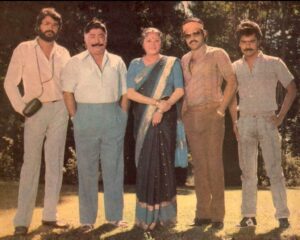
What a blessing it was! In a church, in the omnipresence of God and surrounded by these stalwarts. (Years later, I did ‘Thaikkoru Thaalattu’ with Sivaji & Padmini in 1986 and also worked for Sivaji Productions’, “Kalainjan” in 1993.)
Another chase sequence in the same film was shot at Salt Coutars, Madras. A night effect sequence on the train tracks, beside mammoth warehouses surrounded by tall iron fences. By now, K. S. Prakash turned independent and backed off this project. The onus fell on me to design the lighting. My father being the director was busy briefing the actors, checking the wardrobe and overseeing the placement of cameras.
I remember placing a 5kW behind the iron fence and throwing its shadow across the warehouse. After a multiple light placements, I went to check the frame. He simply asked me, “Are you ready?, let’s shoot…”
I became his preferred cameraman for his next three directorial movies. His favourite though was A. Venkat.

Another incident I’d like to share is about a flash back scene in ‘Naam Pirandha Mann’. My father decided to shoot the flash back scene with fogged film stock. (Irregular roll ends or repacked rolls in storage are often tested for base fog, if it returns positive for base fog, then the can is shelved.)
Each can had varied levels of base fog and the final results differed. He loved to experiment and innovate. He loved to share his in-depth knowledge and experience to his disciples or any who seek his advice.
In the years, I worked as an apprentice, as an assistant, as a camera operator under my father, the knowledge transfer took place. I picked the nuances of filmmaking from the best. I was prepping to branch out independently and I did, eventually.
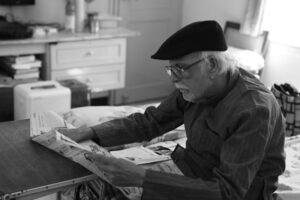
Decades later, my aged father was hospitalized with low sodium in his bloodstream. His memory was fading so was his eyesight. He was getting restless. I was summoned to meet him at the hospital. I was at his bedside when the psychologist walked in. She was an affable young woman and exchanged pleasantries with my father and the caretakers around him. Unexpectedly, she aimed a question at my father. “What is your profession, Mr. Vincent?
There was silence, absolute silence in the room. I could see my father glance at the family members around and finally gaze at me. He couldn’t recollect his profession, a creative job he lovingly learnt as a young lad and so skillfully honed to perfection in the last seven decades. I couldn’t watch him struggle for an answer any longer. My emotion got the better of me. I stepped behind the curtain to let a tear roll off my eyes.
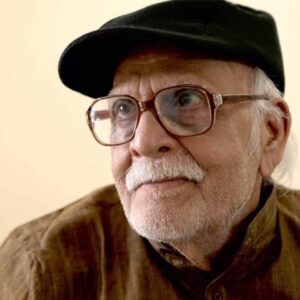
The master always had answers for any queries in an instance but this vital question got him… his profession.
The master peacefully passed away Feb 25, 2015.
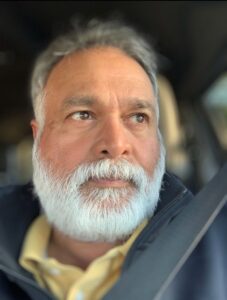
Visual journey of Jayanan Vincent continues to PART 3….stay tuned.
Article by
CJ Rajkumar
Author / Cinematographer
